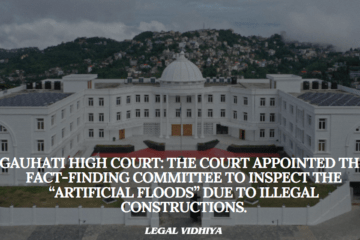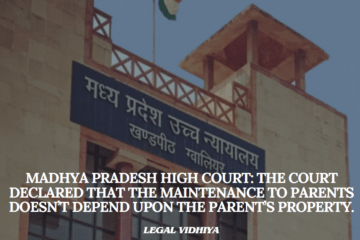
Justice SUDHANSHU DHULIA and Justice PRASANNA B. VARALE observed that the literal meaning of Section 5 of the Limitation Act,1963 should be enlarged by taking into consideration the liberal construction of the said section to determine and broaden the scope of delay in filing the petition or application before the Court of Law backed by sufficient cause.
The dispute was regarding the property in a village located at Gharsaniya, Pargana Dewa,
which was sold by the Respondent No. 4 herein to one Mansa Ram(Respondent No. 5 herein), Thereafter, the property was sold by Respondent No. 5 to the appellant. A suit for permanent injunction was filed by Respondent No 1,2 and 3 against the appellant. Here the appellant was the defendant. The claim of Respondents were that they are the joint owner of suit Property and are also in the possession of the same because the predecessor-in-interest of the property was their uncle and he had executed a will deed in their favour Further, they claimed that the respondent no.4 who sold the land to the appellant had no right to transfer the property. After serving the notice to the appellant (K.B. Lal) and filing the vakalatnama, he did not submit the written statements and an ex parte order was passed against him. The trial court ordered to fill an application under Order IX, Rule 7 of the Code of Civil Procedure, 1908 for the appellant to cite valid reasons for his non appearance to set aside the ex parte order but it was done by the appellant after inordinate delay of 11 years in the year 2017.
The appellant expressed that he did not received the summon and notice of the case . His advocate who was representing him was indiligent and stayed in another city ,which caused him to appoint another advocate named Shri R.D. Rastogi in May 2006 and it was only in the year 2011, when he
inspected the case file himself when he came to know about the order in 2006 but it still took him 6 years to file the application under Order IX, Rule 7 of CPC,1908.Even this application, filed in the year 2017, accurate facts were not admitted. Finally,another application under Order IX, Rule 7 of the CPC came to be filed yet again by the appellant on 23.11.2020 which was again dismissed in 2021 because of inaccurate reasons of delay and contradictory statements.
In 2022, the appellant filed a Civil Revisional Application before the Additional District Judge revisional court, upon examination of the material on record, found that the first application under Order IX, Rule 7 of the CPC which was filed by the appellant on 01.09.2017, was not pressed, owing to the fact that initially in the absence of the appointed advocate, his Junior advocate misrepresented the facts in the first application. Hence, another advocate filed the second application on 23.11.2020, mentioning the correct
facts. Yet, the signature on the first application filed in the year 2017 and on that of the second application filed in the year 2020 were of the same advocate, namely, Shri R.D. Rastogi. It was also averted that appellant was put into the dark by the counsel whose name remains unambiguous. It was held by the Revisional Court that the application under Order IX, Rule 7 of the CPC, 1908 which had to be filed in 2006 by the appellant was filed after the inordinate delay of 14 years by not giving a proper sufficient cause for such an unprecedented delay . Hence the Revisional Court found the error in the application and was dismissed.
Later on the appellant invoked the revisional jurisdiction under Article 227 of the Constitution of India,1950 which was dismissed by the High Court on the same grounds as that of the revisional court and trial court for the appellant not having a good cause for such delay in filing the application under Order IX, Rule 7 of CPC.1908. in 2022.
The Supreme Court held that the term “ sufficient cause” is to provide justice by not dismissing the case with valid reasons for delay . In the case of Basawaraj and Anr. v. Special Land Acquisition Officer, the words ‘sufficient cause’ in Section 5 of the Limitation Act can only be given a liberal construction, when no negligence, nor inaction, nor want of bona fide is imputable to the litigant. Further the court stated that the liberal construction for condensation of delay should be for bonafide reason , lack of negligence, reasonableness for delay and emphasize fairness over technicalities.
“ There is a distinction between inordinate delay and a delay of short duration or few days, for to the former doctrine of prejudice is attracted whereas to the latter it may not be
attracted. That apart, the first one warrants strict approach whereas the second calls for a
liberal delineation.”
Thus, the Supreme Court considered the decision of the Trial and Revisional Court to be fair and dismissed the imputed order by the appellant
CASE TITLE : K.B. LAL VS GYANENDRA PRATAP & ORS , 2024 INSC 281
Written by: Ayesha Hussain, College name : Surendranath Law College, 4th year B.A.LL.B(HONS),Intern under Legal Vidhiya
REFERENCES
Basawaraj and Anr. v. Special Land Acquisition Officer.,
(2013) 14 SCC 81
https://indiankanoon.org/doc/70974484/?type%3Dprint
https://www.aftdelhi.nic.in/assets/pending_cases/2023/OA/oa%203224
Riya Rathore,Vedictum, (April 9, 2024, 11: 00 AM) https://www.verdictum.in/court-updates/supreme-court/kb-lal-v-gyanendra-pratap-2024-insc-281-section-5-limitation-act-sufficient-cause-negligence-bonafide-inordinate-delay-1529721
Disclaimer: The materials provided herein are intended solely for informational purposes. Accessing or using the site or the materials does not establish an attorney-client relationship. The information presented on this site is not to be construed as legal or professional advice, and it should not be relied upon for such purposes or used as a substitute for advice from a licensed attorney in your state. Additionally, the viewpoint presented by the author is of a personal nature




0 Comments